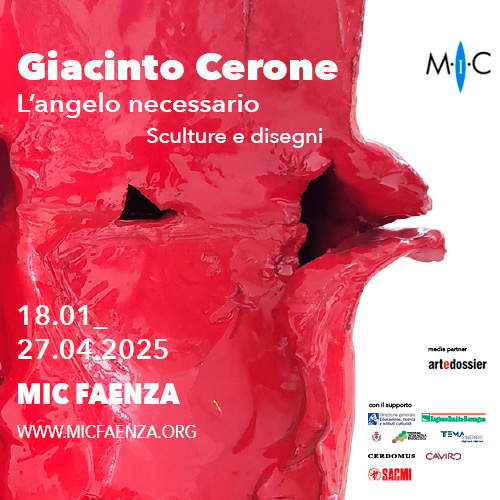L'Aquila, statue found, probably a St. Christopher. Origin is yet to be discovered
The Soprintendenza Archeologia Belle Arti e Paesaggio for the provinces of L’Aquila and Teramo reports that, during renovation and redevelopment work in L’Aquila ’s Piazza Chiarino carried out last October, a white stone statue about 37 centimeters high depicting an armed warrior was found, in addition to some burials without grave goods and some stone and brick finds from the disappeared church of Saints Justin and Martin. The Superintendent’s Office says it could be a depiction of a nobleman or, more likely, St. Christopher, characterized by his thick beard and marked facial features. The figure also wears a pleated skirt with a conspicuous belt, from which a sword hangs. The cloak is tied around the neck and on the left shoulder rests an element that seems to encircle the warrior’s shoulders with the lower end characterized by elaborate drapery, while the upper end is mutilated.
According to the Superintendency, the hypothesis that it may be a Saint Christopher seems the most valid because the saint is always depicted as a giant (he was a native of the barbarian tribe of the Anthropophagi), carrying on his huge shoulders the Child Jesus (an element that is lacunar today, but he certainly wore a tunic as can be guessed from the presence of the drapery), who in turn holds up the world symbolized by an orb.
The cult for the “Christ-bearer” was widespread in Abruzzo’s territory: among the many preserved testimonies is a painting by Francesco di Paolo da Montereale, still visible today in the heart of L’Aquila’s historic center, at the intersection of Corso Vittorio Emanuele and Via Leosini. The fresco is located not far from Piazza Chiarino where, until 1931, the year of its demolition, stood the church dedicated to Saints Justin and Martin. Perhaps the found statuette came from this building, thus testifying to the devotion of the people of L’Aquila to one of the fourteen Auxiliary Saints particularly invoked during natural disasters or for protection from grave dangers. St. Christopher’s patronage was invoked especially during plague epidemics, which often recurred in L’Aquila in the first centuries of its history.
The burials found, as well as the faint traces of foundations, are also to be related to the pre-existing church.
As reported by historian Luigi Lopez, the Church of Saints Justin and Martin was a building of modest proportions, which nevertheless also held the title of Badia: it had been erected by the people of Villa San Giustino, a small town near Paganica, which is why it was consecrated to the saint of the same name. The church of San Giustino, at the end of the 15th century, appears to have been administered by the headquarter church of Santa Maria Paganica, since it no longer had parishioners of its own; later, at an unspecified time, it was ceded to the parish of St. Martin of Chiarino, thus assuming the name of the church of Saints Justin and Martin, while the aggregates of houses around it became the seat of the “local” of Chiarino, whose toponymic memory remains in the present-day naming of Chiarino Square. Instead, the location of the primitive church erected by the inhabitants of Chiarino can be identified in the Town Plan drawn by engineer Vandi and engraved in 1753, immediately next to the convent of the Carmelites officiating at the Church of the Carmine. However, Vandi, in the legend accompanying the plan, gives the information that at that date San Martino was “ruined,” although it is impossible to establish with absolute certainty whether this was a consequence of the 16th-century demolitions for the building of the Castle by the Spaniards or the cause is to be recognized in the collapses caused by the Great Earthquake of 1703.
Just as it is not known whether collapse materials from the facade of the ancient San Martino, which stood near the Castle, were relocated to Chiarino Square when the parish title was moved to its new location. Period photos show that the demolished church had a horizontally crowned façade with a bell gable and a modest column-less portal surmounted by a square window, on the left flank another portal similar to the main one and a pair of windows with stone embrasures. Deconsecrated and left without filians and deprived of rents after the 1851 parish reform, it remained under the care of local families and later became a workshop of various artisans. In November 1931 the City of L’Aquila, which had purchased the church for £15,000 from the Congregation of Charity proceeded to demolish it since it was in a precarious static condition.
The origin of the statue, which does not seem to be able to come from the facade of the church in Piazza Chiarino, is yet to be discovered; perhaps it adorned the portal of the church of San Martino al Castello: in this case, the precious sculpture would be dated to the heyday of sacred building in L’Aquila, under the Angevin reigns of Charles I and Charles II, between the late 13th and early 14th centuries.
 |
| L'Aquila, statue found, probably a St. Christopher. Origin is yet to be discovered |
Warning: the translation into English of the original Italian article was created using automatic tools. We undertake to review all articles, but we do not guarantee the total absence of inaccuracies in the translation due to the program. You can find the original by clicking on the ITA button. If you find any mistake,please contact us.





























